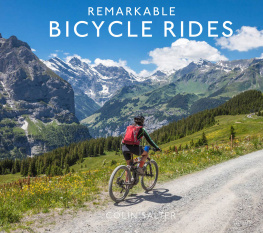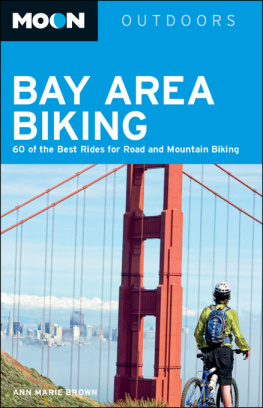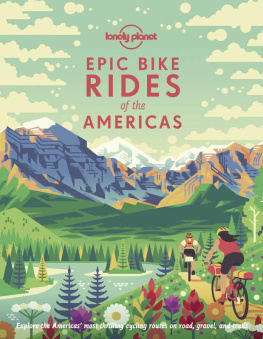Contents
Guide
REMARKABLE
BICYCLE RIDES
REMARKABLE
BICYCLE RIDES
COLIN SALTER


Close to the edge on the White Rim Trail in the Canyonlands National Park, Utah.
Contents

Introduction

Its estimated that more than half of the worlds population can ride a bike, compared to around 17% who think they can drive a car. Concern for the environment, cost, and increased consideration for cycling in urban planning have all contributed to the rise in bike use.
Giant strides have been made in the provision of cycling infrastructure within towns and cities. Separate bicycle lanes with their own traffic signals are common, and commuting to work by bicycle is a much safer proposition today than it was twenty years ago. The more people cycle to work, the fewer people drive to work, the cleaner the air is for those who cycle (or walk) to work.
Cycling is a tremendously efficient way of getting from A to B over short to medium distances. In built-up areas its faster than driving; and the parking is infinitely easier. Its ideal for commuting. Better still, that short ride to work every day is a far more effective way of keeping fit than an occasional longer route.
But cycling is addictive. You find yourself wanting the longer route at the weekend as well as the daily work-out. Its as if those lungs, once opened, want all the fresh air they can get. Those legs, once accustomed to pedalling, must pedal.
In reality, most of us stop before things get too extreme the 1,220km of Chiles Carretera Austral across volcanoes, fjords and glaciers is not for everyone. A family cycling holiday along the banks of the River Loire is a far gentler proposition. A day out every now and then for example Oregons 33-mile Crater Lake Loop around a single volcano would satisfy me and most of my fellow weekend cyclists. (In this book, by the way, we use the local units of distance first, be they kilometres or miles, metres or feet)
But whether youre planning to ride the Great Divide or just dreaming of the Shimanami Kaido, this book offers an armchair taster of 53 remarkable bike rides from around the world to whet your appetite. They vary in length, from the short sharp shock of the Whistler A-Line Singletrack (one and a half miles and five minutes youll never forget) to the seven-country, 6,000 kilometre coastal extravanganza of the North Sea Cycle Route. They vary in altitude and gradient too, from the level paths of the Dutch coast to the lung-busting twists and turns of the Mount Evans Climb in Colorado.
Theres something within every cyclist that loves a challenge. Although many of us think a steep hill spoils an otherwise enjoyable ride, others crave the punishment of a 20% incline. Theres plenty for them in here. The French version of the Camino de Santiago has to cross the Pyrenean Mountains, while in Scotland, the Assynt and Applecross Circuits make no effort to take the low road through the rugged Scottish Highlands. The Alpine Panorama Route through Switzerland crosses four different mountain ranges and in Cuba, La Farola crosses the islands spine on a marvel of mountain road engineering.
Its not always the ascent thats the hard part: the Yungas Road in Bolivia can be ridden downhill all the way but clings to mountains so steep that it is known with good reason as the Road of Death.

Two cyclists tackle the short but steep climb of the Wrynose Pass in Englands Lake District.
Some of the most challenging climbs in cycling are part of its greatest competitions. Mont Ventoux is a regular component of the Tour de France, the Stelvio Pass a favourite in the Italian equivalent, the Giro dItalia, while Tuscanys LEroica is both a race and a celebration of the joys of vintage cycling in the kind of kit Fausto Coppi would have donned.
For the flat-earthers among us, who prefer a less strenuous route, riverside paths and railroad beds offer a pleasant escape from the ups and downs of the landscape, and of life. In Europe, Germany leads the way, with some 37 designated cycle routes along its rivers, including the Elbe, the Rhine, the Main and the upper reaches of the Danube. If you have the time you can follow the Danube for its entire 2,850km length from spring to mouth through ten countries and four capital cities. Parts of it form sections of many other long-distance cycle routes including the excellent EuroVelo network promoted by the European Union. Several EVs are described in whole or in part in this book, including the 7,600km Iron Curtain Trail, EuroVelo 13, which follows the continents sparsely populated former boundaries between Capitalism and Communism.
Railways have even more reliable gradients than riverbanks and, when they close down, rail travels loss is the cyclists gain. The Otago Central Rail Trail in New Zealand and Le Ptit Train du Nord in Canada, having outlived their usefulness to the local gold and timber industries, now serve weekend cyclists instead, carrying more people now than they ever did in their lifetimes. The Parenzana, once the rail link between Italy and Croatia, does even more. It has been repurposed as a bike trail to reconnect two countries once separated by ideologies. The USA is justly proud of its Rails to Trails scheme and two of its most popular rails the Route of the Hiawatha and the Katy Trail are featured here.

Cycle tours can help take the organizational strain, but you will always need to travel at the group speed and stick to a predetermined plan.

A cyclist on the Great North Trail passing through the Yorkshire Dales.

The Route of the Hiawatha accomplishes a rare feat. Cyclists can enjoy an exhilarating ride in mountainous country, while pedalling on the flat.
The Katy Trail follows the Missouri river and passes the city of Hermann, the self-styled Sausage Capital of Missouri: its not always about the cycling. Besides the mountains, the Swiss Alpine Panoramic Route also encompasses several of the countrys world-famous cheese-making towns. There are many cycling circuits in Flanders dedicated to the regions prowess at brewing beer. And in Burgundy you can follow the Route des Grands Crus for a finely judged balance and balance is an important thing here of cycling and wine-tasting.
If your sea legs are as strong as your cycling legs, you may enjoy a spot of island-hopping. Island communities often have their own values and lifestyles, and in this book we look at four archipelagos which can be explored by bike via ferries or bridges, in Norway, Japan, Scotland and Washington State.




















